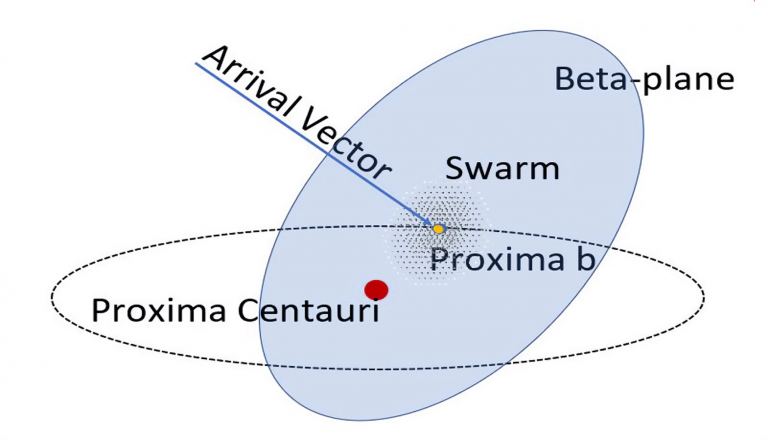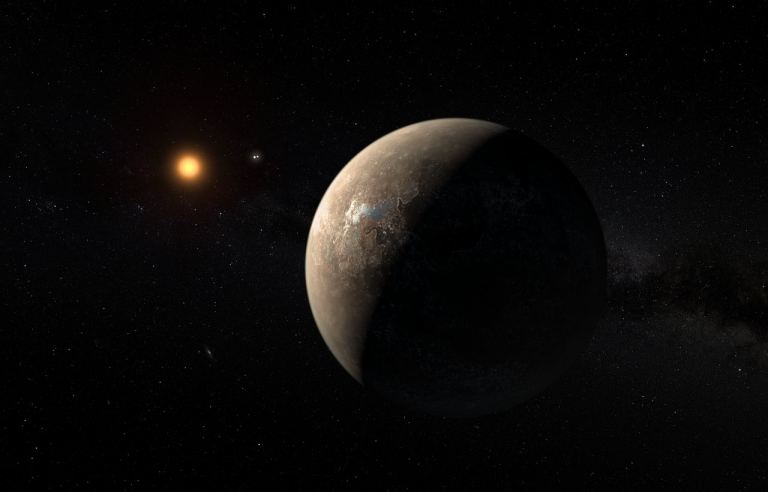NASA Chooses Ambitious Plan to Deploy Small Probes to Swarm Proxima Centauri
For generations, humans have harbored dreams of venturing to distant star systems and exploring alien worlds. However, the reality of interstellar exploration is undeniably daunting. As we discussed in a previous article, conventional propulsion methods would require an astonishingly long time, ranging from 1000 to 81,000 years, for a spacecraft to reach Alpha Centauri. Moreover, the interstellar medium (ISM) poses numerous risks during such journeys, many of which remain poorly understood.
Given these circumstances, the most feasible option for reaching neighboring stars within this century seems to be gram-scale spacecraft propelled by directed-energy, specifically lasers. One such concept is the Swarming Proxima Centauri, a collaborative project between Space Initiatives Inc. and the Initiative for Interstellar Studies (i4is), spearheaded by Marshall Eubanks, the chief scientist at Space Initiatives. This concept has recently been chosen for Phase I development as part of NASA’s Innovative Advanced Concepts (NIAC) program for this year.
According to Eubanks, interstellar travel hinges on three key factors: distance, energy, and speed. Even Proxima Centauri, located 4.25 light-years (40 trillion km; 25 trillion mi) away from our Solar System, is unimaginably distant. To put it into perspective, the Voyager 1 space probe currently holds the record for the farthest distance traveled by a spacecraft, surpassing 24 billion km (15 billion mi) from Earth. Utilizing conventional methods, the probe achieved a maximum speed of 61,500 km/h (38,215 mph) and has been journeying for over 46 consecutive years.

To put it briefly, interstellar travel becomes extremely time-consuming and impractical unless one is traveling at relativistic speeds, which are a fraction of the speed of light. The energy requirements for such travel are immense, making it feasible only for small spacecraft weighing a few grams at most. In an email to Universe Today, Eubanks explained that rockets are commonly used for fast travel. Rockets operate by expelling hot gas or “stuff” in the opposite direction, with the momentum of the expelled material equaling the velocity increase of the vehicle in the forward direction. The efficiency of rocketry depends on the backward velocity of the expelled material being comparable to the desired forward velocity. If the backward velocity is significantly smaller, it becomes impossible to carry enough material to achieve the desired velocity.
The challenge lies in the fact that we currently lack the technology or an energy source that would allow us to expel a large amount of material at speeds close to 60,000 km/sec. Therefore, rockets are not a viable option. While antimatter could potentially solve this problem, our understanding of antimatter is limited, and we are unable to produce sufficient quantities of it. This solution is likely many decades away.
In contrast, concepts like Breakthrough Starshot and the Proxima Swarm propose an alternative approach known as “inverting the rocket.” Instead of expelling material, these concepts involve throwing material at the spacecraft. Rather than relying on heavy propellant, which constitutes the majority of conventional rockets, a lightsail spacecraft utilizes photons (which have no mass and travel at the speed of light) as its energy source. However, as Eubanks pointed out, this does not resolve the energy issue, making it even more crucial for the spacecraft to be as small as possible.

The speed-of-stuff problem can be resolved by bouncing photons off a laser sail, according to the speaker. However, the challenge lies in the fact that photons have minimal momentum, necessitating a large quantity of them. Additionally, despite the anticipated availability of significant power in the future, the thrust generated will still be weak. Consequently, the mass of the probes needs to be extremely small, measured in grams rather than tons.
Their proposal entails utilizing a 100-gigawatt (GW) laser beamer to propel thousands of gram-scale space probes equipped with laser sails to achieve relativistic speeds, approximately 10-20% of the speed of light. To ensure effective communication as the probes venture towards Proxima Centauri, they also suggest implementing a network of terrestrial light buckets spanning a square kilometer in diameter. These light buckets will capture the signals emitted by the probes, which become increasingly challenging to receive as the distance grows. According to their projections, this mission concept could be developed by the middle of the century and potentially reach Proxima Centauri, along with its Earth-like exoplanet (Proxima b), by the third quarter of the 21st century, specifically around 2075.
In a previous publication, Eubanks and his colleagues demonstrated how a fleet of one thousand spacecraft could overcome the obstacles associated with interstellar travel and maintaining communication with Earth by employing swarm dynamics. “By increasing the collecting area to a feasible 1 km2 and coordinating the transmissions of multiple probes, we can achieve a reasonable bit rate,” he further explained. However, due to the eight-year round-trip communication delay caused by interstellar distances and the effects of General Relativity, it is impossible to remotely control the probes from Earth.
The swarm must have a high level of autonomy in terms of navigation (coordinating a thousand probes) and determining which data is sent back to Earth. These strategies tackle the challenges of distance, energy, and speed (at least for now), but there remains the question of the cost involved in creating the swarm and its infrastructure. The laser array itself will be the most expensive component, while the gram-scale craft will be relatively inexpensive to manufacture. According to Eubanks’ statement to Universe Today in a previous article, their proposal can be implemented with a budget of $100 billion.

However, Eubanks has consistently emphasized the numerous benefits of the mission architecture they have envisioned. The potential rewards of sending a swarm of probes to Proxima Centauri would be astronomical:
It is important to note that the primary cost of a laser-propelled interstellar mission, which involves lightweight probes propelled by a massive laser system, lies in the capital costs associated with the laser system. In comparison, the probes themselves would be relatively inexpensive. Therefore, if it is possible to send multiple probes, it is highly recommended to do so. The advantage of sending a large number of probes lies in redundancy. Space travel is inherently risky, and interstellar travel is expected to be even riskier. By sending a significant number of probes, we can tolerate a higher loss rate while still achieving our objectives. However, the advantages extend beyond redundancy.
Our objective is to search for signs of biology and technology, making it crucial to position probes in close proximity to the planet in order to obtain high-resolution images and spectra of its surface and atmosphere. This task would be challenging for a single probe, as we cannot accurately predict the planet’s location 24 or more years into the future. By deploying a group of probes in a spread formation, we increase the likelihood that at least a few will come close to the planet, providing us with the desired close-up view.
Furthermore, Eubanks and his colleagues anticipate that the development of a coordinated swarm of robotic probes will have practical applications closer to home. Swarm robotics is currently a thriving field of research, with potential applications including exploring Europa’s interior ocean, constructing underground cities on Mars, assembling large structures in space, and enhancing extreme weather tracking from Earth’s orbit. In addition to space exploration and Earth observation, swarm robotics holds promise in fields such as medicine, additive manufacturing, environmental studies, global positioning and navigation, search and rescue operations, and more.
Eubanks and his colleagues express their honor and excitement as they are chosen as part of NASA’s selectees for the 2024 NIAC program. Although it may still require several decades before an interstellar mission is prepared to journey to Alpha Centauri, their research has brought them closer to this realization than ever before. Eubanks acknowledges the lengthy process, spanning almost a decade, and feels privileged to have been selected. He emphasizes that now is the time for the actual work to commence.
Do not forget to share your opinion with us to provide you with the best posts !



0 Comments